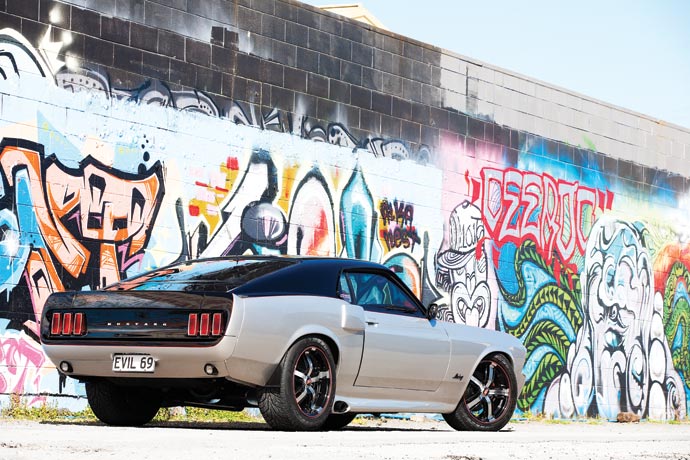data-animation-override>
“Published in NZV8 Issue No. 90”

After building and selling a ’58 Chev, Terry Blake swore he’d never do it again. That was until he stumbled upon a 1969 Mustang sitting in the back of a panel shop. The car was an inch thick in dust, but the bodywork had been done, and it was in primer, so the theory was it wouldn’t take much to get it back on the road, or so he thought.
A car-and-bike guy by nature, and not one to ever leave things alone, that plan soon blew out, as deep down he knew he wanted to build something different. “I build my bikes so that if people don’t know what they’re looking at, they think they look nice, but if they do know, they’ll really stop and look to work out what’s been done, and I wanted the same for this. I had a plan in my head of what it could look like, and it would really get those who knew their Mustangs scratching their heads, while non-car people would simply walk past,” says Terry of his plan.
Being in the industry as the supplier of Seetal Spraybooths, Terry had a long list of panel beaters and painters that he could turn to. It was when he started bouncing ideas off Hamilton’s Ken Braun though that he knew he was the man for the job.
Intuiting that people would be quick to try and fault any workmanship on the vehicle, Ken and Terry realized they needed a failsafe course of action, and it was one that would involve stripping the car right back to bare metal and doing it properly, making it impossible to find fault with the work, or the finish.
With Terry being on the road most of the time, he’d pop in to see Ken and the car every time he was in Hamilton, and after each visit the scope of the undertaking stretched a little further. While the idea was never to build an Eleanor clone (the car is the wrong year and shape to start with anyway), Terry had always liked the look of the Eleanor-style bumpers, so he ordered a kit. Those who know their Mustangs will know that the ’69 is a lot wider than the ’67s that the Eleanors were built on, and that fitting a bumper designed for one to the other is no easy task. That’s exactly what Ken and his team set about achieving though, which saw a serious amount of work go into getting it to fit. Sharp eyes will notice that two grilles have been joined to fill the larger frontal area, as well as many other custom touches.
Where the Eleanors wear an over-fender, Ken and the team stretched and reworked the ’69’s guards to follow the sharp lines of the bumper. As work continued, the car began to take on more of its own personality and custom shape, which was aided by Eleanor side skirts being moulded to the body and both wheel arches also being re-profiled. The more you look, the more custom touches you’ll see on the car that you miss at first glance, but such is the planning and workmanship, that all of the custom mods look as though could have been that way from the factory.

The rear end of the car is a work of art, and while it’s not stock, again, you need to know what it did look like originally to work out what’s been done. The trick was the removal of the centre fuel filler, and the dropping of the Mustang lettering from the boot lid to the tail panel. With fuel fillers now on each flank, the rear end almost makes the car look more modern than it is, the painting and flush-fitting of the rear bumper adding to that illusion. Speaking of the rear bumper, it’s actually been recreated out of fibreglass, to allow it to sit so close to the body.
When it came time for paint, various two-tone ideas were bandied about, however the colour was always going to end up being black and silver with red accents. The way the red keyline has been used to accentuate the colour-split works perfectly, and it’s enhanced by a set of RimPro-Tecs having been added to the 18-inch wheels.

Since the 351 Windsor in the car was there before he bought it and had previously been rebuilt with plenty of new and upgraded components (such as a fairly lumpy camshaft), Terry decided the only change he’d make to it was to fit a bug catcher. Kevin from CSR in Taranaki was responsible for finishing off many details in the engine bay, along with sorting out the SSBC brake kit and custom-building the side-exiting exhausts.
The intention from the start was for something that could make regular trips from Auckland to Bay of Islands without ever leaving him stranded, and although the car has only recently been completed, so far it’s lived up to those expectations. And just as expected, it’s picked up many admiring glances along the way, with passers by that know what they’re looking at, always coming back for a second look, scratching their heads to work out what’s going on, exactly as we did when we first laid eyes on it.
This, of course, was exactly what he was after with the build from the outset, and while he says he won’t do another one, he did let slip a few more ideas he’s got in mind, so we’re guessing it won’t be too long before this car’s got an equally as impressive stablemate, and just like the Mustang, you can guarantee you’ll never have seen another one like it.
Specs
Engine: 351 Windsor, MSD ignition, Holley Carb, bug catcher, custom exhaust, alloy radiator
Driveline: Ford Toploader manual gearbox (soon to be AOD Automatic Transmission), stock diff
Suspension: Stock
Brakes: SSBC disc brake kit
Wheels/tyres: 18×8-inch wheels, 235/55R18 and 255/55R18 tyres, RimPro-Tec
Exterior: Custom front end, custom sills, custom grille, flushed handles, re-shaped wheel arches, duel fuel fillers, custom rear bumper, PPG paint
Interior: Auto Meter gauges, custom re-trim, Sony/Kicker audio, Vintage Air AC
Performance: Untested

Driver Profile
Terry and Karen Blake
Age: 56
Occupation: Owner of Seetal Spraybooths
Previously owned cars: ’58 Chev, Dodge Ram, Harleys
Dream car: Corvette
Why the Mustang? Karen likes them
Build time: Four years
Length of ownership: Four Years
Terry thanks: Ken Braun, Kevin Walsh, PPG, Smits Group
Words: Todd Wylie
Photos: Adam Croy


